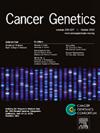In silico protein structural analysis of PRMT5 and RUVBL1 mutations arising in human cancers
IF 2.1
4区 医学
Q4 GENETICS & HEREDITY
引用次数: 0
Abstract
DNA double strand breaks (DSBs) can be generated spontaneously during DNA replication and are repaired primarily by Homologous Recombination (HR). However, efficient repair requires chromatin remodeling to allow the recombination machinery access to the break. TIP60 is a complex conserved from yeast to humans that is required for histone acetylation and modulation of HR activity at DSBs. Two enzymatic activities within the TIP60 complex, KAT5 (a histone acetyltransferase) and RUVBL1 (an AAA+ ATPase) are required for efficient HR repair. Post-translational modification of RUVBL1 by the PRMT5 methyltransferase activates the complex acetyltransferase activity and facilitates error free HR repair. In S. pombe a direct interaction between PRMT5 and the acetyltransferase subunit of the TIP60 complex (KAT5) was also identified. The TIP60 complex has been partially solved experimentally in both humans and S. cerevisiae, but not S. pombe. Here, we used in silico protein structure analysis to investigate structural conservation between S. pombe and human PRMT5 and RUVBL1. We found that there is more similarity in structure conservation between S. pombe and human proteins than between S. cerevisiae and human. Next, we queried the COSMIC database to analyze how mutations occurring in human cancers affect the structure and function of these proteins. Artificial intelligence algorithms that predict how likely mutations are to promote cellular transformation and immortalization show that RUVBL1 mutations should have a more drastic effect than PRMT5. Indeed, in silico protein structural analysis shows that PRMT5 mutations are less likely to destabilize enzyme function. Conversely, most RUVBL1 mutations occur in a region required for interaction with its partner (RUVBL2). These data suggests that cancer mutations could destabilize the TIP60 complex. Sequence conservation analysis between S. pombe and humans shows that the residues identified in cancer cells are highly conserved, suggesting that this may be an essential process in eukaryotic DSB repair. These results shed light on mechanisms of DSB repair and also highlight how S. pombe remains a great model system for analyzing DSB repair processes that are tractable in human cells.
人类癌症中PRMT5和RUVBL1突变的硅蛋白结构分析。
DNA双链断裂(DSBs)是DNA复制过程中自发产生的,主要通过同源重组(Homologous Recombination, HR)修复。然而,有效的修复需要染色质重塑以允许重组机制进入断裂。TIP60是一种从酵母到人类保守的复合物,是组蛋白乙酰化和调节dsb的HR活性所必需的。TIP60复合体内的两种酶活性,KAT5(一种组蛋白乙酰转移酶)和RUVBL1(一种AAA+ atp酶)是有效的HR修复所必需的。PRMT5甲基转移酶对RUVBL1的翻译后修饰激活了复合体乙酰转移酶的活性,促进了无错误的HR修复。在S. pombe中,PRMT5与TIP60复合体的乙酰转移酶亚基(KAT5)之间的直接相互作用也被发现。TIP60复合物已经在人类和酿酒链球菌的实验中得到了部分解决,但在pombe中还没有。本研究采用硅蛋白结构分析方法研究了S. pombe与人类PRMT5和RUVBL1之间的结构保守性。结果表明,与酿酒酵母相比,pombe酵母与人蛋白在结构保守性上更为相似。接下来,我们查询了COSMIC数据库来分析人类癌症中发生的突变如何影响这些蛋白质的结构和功能。预测突变促进细胞转化和永生的可能性的人工智能算法表明,RUVBL1突变应该比PRMT5具有更剧烈的影响。事实上,硅蛋白结构分析表明,PRMT5突变不太可能破坏酶的功能。相反,大多数RUVBL1突变发生在与其伴侣(RUVBL2)相互作用所需的区域。这些数据表明,癌症突变可能破坏TIP60复合物的稳定性。对S. pombe和人类之间的序列保守性分析表明,在癌细胞中发现的残基高度保守,表明这可能是真核生物DSB修复的重要过程。这些结果揭示了DSB修复的机制,也强调了S. pombe如何仍然是分析人类细胞中易于处理的DSB修复过程的一个很好的模型系统。
本文章由计算机程序翻译,如有差异,请以英文原文为准。
求助全文
约1分钟内获得全文
求助全文
来源期刊

Cancer Genetics
ONCOLOGY-GENETICS & HEREDITY
CiteScore
3.20
自引率
5.30%
发文量
167
审稿时长
27 days
期刊介绍:
The aim of Cancer Genetics is to publish high quality scientific papers on the cellular, genetic and molecular aspects of cancer, including cancer predisposition and clinical diagnostic applications. Specific areas of interest include descriptions of new chromosomal, molecular or epigenetic alterations in benign and malignant diseases; novel laboratory approaches for identification and characterization of chromosomal rearrangements or genomic alterations in cancer cells; correlation of genetic changes with pathology and clinical presentation; and the molecular genetics of cancer predisposition. To reach a basic science and clinical multidisciplinary audience, we welcome original full-length articles, reviews, meeting summaries, brief reports, and letters to the editor.
 求助内容:
求助内容: 应助结果提醒方式:
应助结果提醒方式:


